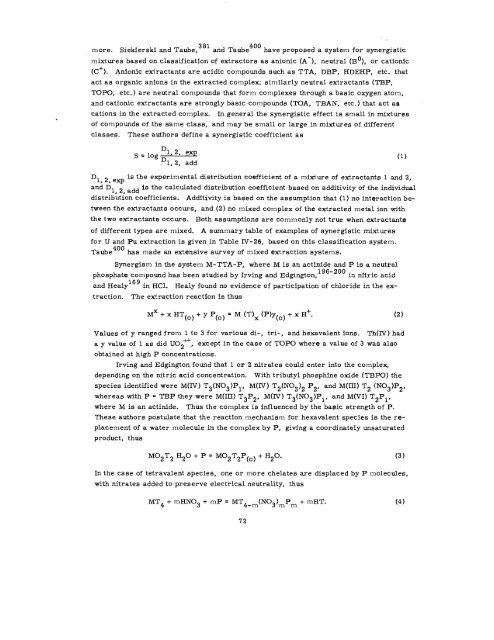THE RADIOCHEMISTRY OF PLUTONIUM - Sciencemadness.org
THE RADIOCHEMISTRY OF PLUTONIUM - Sciencemadness.org
THE RADIOCHEMISTRY OF PLUTONIUM - Sciencemadness.org
You also want an ePaper? Increase the reach of your titles
YUMPU automatically turns print PDFs into web optimized ePapers that Google loves.
.<br />
more. Siekierski and Taube, 381 and Taube400 have proposed a system for synergistic<br />
mixtures based on classification of extractors as anionic (A-), neutral (B”), or cationic<br />
(C+). Anionic etiractantfi are acidic compounds such as TTA, DBP, HDEHP, etc. that<br />
act as <strong>org</strong>anic anions in the extracted complex; similarly neutral extractants (TBPJ<br />
TOPO, etc. ) are neutral compounds that form complexes through a basic oxygen atom,<br />
and cationic extractants are strongly basic compounds (’I?OA, TBAN, etc. ) that act as<br />
cations in the extracted complex. In general the synergistic effect is small in mixtures<br />
of compounds of the same class, and may be small or large in mixtures of different<br />
classes. These authors define a synergistic coefficient as<br />
‘1 2, ex<br />
s = 10g D1’ z adj (1)<br />
,,<br />
‘1,<br />
is the experimental<br />
2, exp<br />
distribution coefficient of a mixture of extractants 1 and 2,<br />
and ‘1,<br />
is the calculated<br />
2, add<br />
distribution coefficient based on additivity of the individual<br />
distribution coefficients. Additivity is based on the assumption that (1) no interaction be-<br />
tween the extractants occurs, and (2) no mixed complex of the extracted metal ion with<br />
the two extractants occurs. Both assumptions are commonly not true when extractants<br />
of different types are mixed. A summary table of examples of synergistic mixtures<br />
for U and Pu extraction is given in Table IV- 26, based on this classification system.<br />
Taube400 has made an extensive survey of mixed extraction systems.<br />
Synergism in the system M- TTA-P, where M is an actinide and P is a neutral<br />
phosphate compound has been studied by Irving and Edgington,<br />
196-200 in nitric acid<br />
169 inHCl<br />
and He aly Healy found no evidence of participation of chloride in the ex-<br />
traction. The extraction reaction is thus<br />
‘x +xHT(0) +J’ p(o)<br />
‘ M (T)x (P)y(o) + X H+. (2)<br />
Values of y ranged from 1 to 3 for various di-, tri-, and hexavalent ions. Th(IV) had<br />
a y value of 1 as did U02+, except in the case of TOPO where a value of 3 was also<br />
obtained at high P concentrations.<br />
Irving and Edgington found that 1 or 2 nitrates could enter into the complex,<br />
depending on t$e nitric acid concentration. With tributyl phosphine otide (TBPO) the<br />
species identified were M(IV) T3(N03)P1, M(m) T2(N03)2 P2, and M(~I) T2 (N03)P2,<br />
whereas with P = TBP they were M(IH) T3P2, M(W) T3(N03)P1, and M(VI) T2P1,<br />
where M is an actinide. Thus the complex is influenced by the basic strength of P.<br />
These authors postulate that the reaction mechanism for hexavalent species is the re-<br />
placement of a water molecule in the complex by P, giving a coordinately unsaturated<br />
product, thus<br />
M02T2 H20 + P = M02T2P(0) + H20. (3)<br />
In the case of tetravalent species, one or more chelates are displaced by P molecules,<br />
with nitrates added to preserve electrical neutrality, thus<br />
MT4 + mHN03 + mP = MT4-m(N03)mPm + mHT. (4)<br />
’72
















